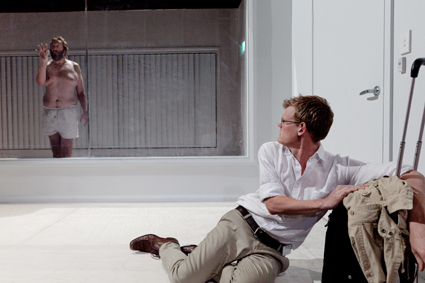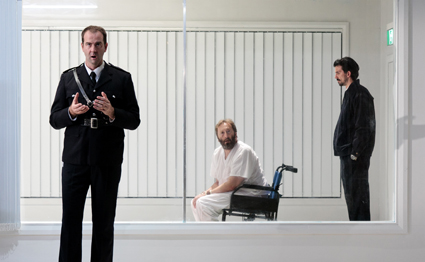the horror
keith gallasch: sydney chamber opera, in the penal colony

Anthony Hunt, Pascal Herington, In the Penal Colony
photo Louis Dillon Savage
Anthony Hunt, Pascal Herington, In the Penal Colony
A WIDE ARC OF BLOOD SPATTERS ACROSS A WINDOW; IT IS BLUE—THE BLOOD LITERALLY AND METAPHORICALLY OF THE OFFICER WHO, IN DESPAIR AT HIS LOSS OF POWER IN A PENAL COLONY, HAS SUBJECTED HIMSELF TO AN EXECUTION DEVICE THAT, OVER 12 HOURS, IN A TORTUROUS TATTOOING, NEEDLING DEEPER AND DEEPER INTO HIS SKIN, SPELLS OUT THE COMMANDMENT A CRIMINAL HAS BROKEN.
Believing that at the moment of death the criminal achieves transcendent self-awareness, The Officer desires it for himself, but, its maintenance underfunded by a new commandant, the machine brutally malfunctions.
For The Officer, the power of one body, authority, over another is justice enough—the criminal need not know his offence (until the moment of death) or have the right to defence. As ever, Kafka (even if this is denied by those who regard him simply as a metaphysician) is prescient—fascism was to be supremely exercised by physical force—and historically alert. Although the Enlightenment tide began to turn against torture and violent execution in the 18th century, these contested punishments persisted, not least in European colonies in the 19th and 20th centuries, and into our own. In Kafka’s story, the setting is a penal colony in the tropics, the sweat and grit as palpable as the ugly specifics of the machine and cruelties more explicit than in Philip Glass’ opera.
However, in editing the story and paring back detail, composer Glass and librettist Rudolph Wurlitzer have provided the opportunity for directors to circumvent the demands of too many specifics, including historical placement, without necessarily reducing the potential for horror. The machine need not appear, the execution need not be seen—the anxiety and shock can be expressed principally in words and the haunting pulse of Glass’ score. Glass’ affinity is, after all, with Baroque opera rather than the denser theatricality of its 19th century successor.
Director Imara Savage and designer Michael Hankin make the most of this opportunity, filling the width of the stage with a long, shallow, starkly white room with vertical blinds at the back. These are later half-opened to reveal what appears to be an identical room behind glass, housing the implement of execution, which remains hidden and therefore all the more anxiety-inducing. The sheer lack of identity of the rooms is nightmarishly, if predictably Kafka-esque. A lone water cooler stands to one side, its contents ominously turning blue shortly before the execution device fails. A screen descends on which The Officer shows The Visitor (the Explorer in Kafka’s tale) the machine; the images are not of a concocted device, but made up of old black and white film footage of 20th century industrial machinery—spinning cogs and lathes counterpointing Glass’ insistent pulse—and worrying scientific implements of unknown purpose. Like the Officer’s uniform, appearing to be from the 1940s or 50s, they suggest a not too distant past that still lingers, while The Visitor is in modern dress.
The Visitor at first seems to be the character with whom we’ll identify. Like us, he’s a stranger to the penal colony. He’s keen to maintain an emotional remove, to simply be an observer. But The Officer treats him as confidant, fascinating and finally repelling The Visitor with his account of the machine and its torments and his attempts to inveigle his guest into suppressing any opposition to the device. That The Visitor takes so long to express his concern distances us from him, despite our understanding of his unenviable position; at the very same time we fully grasp the mania that inhabits The Officer and feel as helpless as The Visitor. The reversal, when it comes, the Officer substituting himself for the Condemned Man, is a shocking climax to a chilling tale.

Paul Goodwin-Groen, Anthony Hunt, Patrick George, In the Penal Colony
photo Louis Dillon Savage
Paul Goodwin-Groen, Anthony Hunt, Patrick George, In the Penal Colony
Director Savage’s direction is as effectively straightforward as the lucid libretto which is delivered with clarity and power by tenor Pascal Hetherington (The Visitor) and baritone Paul Goodwin-Groen (The Officer). Hetherington conveys detachment, curiosity, then horror and panic without embellishing The Visitor with any too distinctive character traits, underlining the man’s attempts to keep his distance, while Goodwin-Groen seizes the opportunity to reveal a slide from apparent rationality into neurosis and then self-destructive psychosis—a frightening portrait of the impact of quasi-religious, self-centred ideology, utterly devoid of empathy.
The singers met the challenging score boldly, as did the offstage conductor and string quintet, sustaining the music’s complex oscillations between driving motifs and reflective decelerations. There are moments in Glass’ score that offer director and performers little in the way of dramatic impulse (for example, when The Officer is installing himself, out of our view, in the execution device). Elsewhere this was, however, an issue of direction: the performers had little to do in some passages, appearing occasionally awkward or aimlessly repetitive in their movement. Likewise the opportunity to exploit the design space was not always taken. As numerous directors have shown in recent decades, Baroque opera, and oratorios even, offer great opportunities for dramatic realisation without it becoming superfluous. The same should apply to In the Penal Colony. Nonetheless the production maintained its sense of suspense, horror and ethical unease.
I was impressed by the Sydney Chamber Opera’s production of In the Penal Colony, for its intimacy of scale (so rare for opera in this city), excellent design, thematic conviction, fine performances and offering the hitherto unlikely opportunity to see this work. This is a company to watch.
Sydney Chamber Opera’s next production is a double bill, Stravinsky’s The Soldier’s Tale and UK composer George Benjamin and librettist Martin Crimp’s Into the Little Hill, with conductor David Stanhope, director Sarah Giles and performers Halcyon at Carriageworks, Sydney, July 24-28. Crimp wrote the plays The Country and The City and created the English version of Botho Strauss’ Gross und Klein (Big and Little Scenes) for Sydney Theatre Company. If you’re interested in hearing In the Penal Colony, after touring the UK with their production in 2010, Music Theatre Wales has released a CD of In the Penal Colony on the Orange Mountain Music label.
Sydney Chamber Opera, In the Penal Colony, composer Philip Glass, libretto Randolph Wurlitzer, performers Pascal Hetherington, Paul Goodwin-Groen, Anthony Hunt, Patrick George, conductor Huw Belling, director Imara Savage, set, costume design Michael Hankin, lighting, AV Verity Hampson, string quintet Doretta Balkizas, Madelaine Slaughter, James Munro, Mee Na Lojewski, Rhiannon Oakhill; Parade Theatre, NIDA, April 7-14; http://sydneychamberopera.com
RealTime issue #109 June-July 2012 pg. 36






